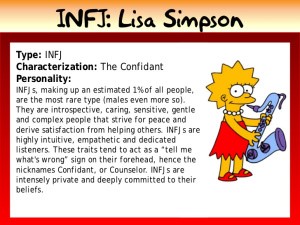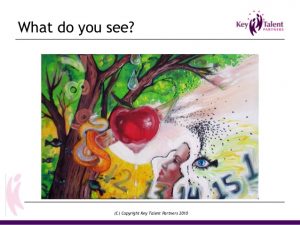10 Chapter 10: The Myers-Briggs Type Indicator
Chapter 10: The Myers-Briggs Type Indicator

“I am not an INFJ but I play one on TV…..”
This make make no sense to you right now, (and no, I’m not an INFJ, but an INFP), but after completing this Chapter it may make more sense. Hopefully you’ve taken the Myers-Briggs Type Indicator already. If not, there’s a nice informal assessment you can take here. https://www.truity.com/test/type-finder-personality-test-new
Introducing The Myers-Briggs Type Indicator:
The Myers-Briggs Type Indicator (MBTI) is a test that is often used in helping people understand themselves better and find preferences. Katharine Cook Briggs and her daughter Isabel Briggs Myers first developed the test during World War II patterning it after psychologist Carl Jung’s theories of personality. It has been refined several times through the years and is used in a variety of areas including leadership training, career exploration, relationship and marriage counseling, employee training, and for personal development.
The Centers for Applications of Psychological Type (CPP) state the MBTI is “the most widely used personality theory in history”. Indeed, the MBTI is used in a variety of areas. From career exploration, to conflict management, to business practices, to many other areas, the MBTI is a widely relied upon tool for providing insight into ourselves and to provide direction for our futures.
Please make a note that the MBTI is designed to measure preferences for different personality types. That is, it directs us to see the way we prefer to do and view things, but we are always capable of looking or doing things another way as well. For example, first try writing your name with the hand you normally write with. Now, try writing your name with the opposite hand. Obviously, you are capable of doing so, but it feels a little different and perhaps a little less comfortable. This is because your preference for writing is your dominant hand—but this is in no way absolute.
Specifically, the MBTI examines four dimensions of personality and determines in each dimension which way we tend to prefer to interact with the world. Those four dimensions are:
- How we direct our energy
- How we gather information
- How we make decisions
- How we deal with the other world
For each dimension, we distinct each into two possibilities, and find people tend to lean towards one possibility or the other. Let’s look more closely at each of these:
How we direct or energy: Extraversion vs. Introversion
People who lean towards extraversion tend to focus on people and things on the outer world. People who lean towards introversion focus on the thoughts, feelings, and impressions of the inner world.
How we gather information: iNtution vs. Sensing
People who lean towards sensing tend to focus on facts and details that can be confirmed by experience. People who lean towards intuition focus on possibilities and relationships among ideas.
How we make decisions: Feeling vs. Thinking
People who lean towards thinking use impersonal, objective, logical analysis to reach conclusions. People who lean towards feeling tend to use person-centered, subjective analysis to reach conclusions.
How we deal with the other world: Perceiving vs. Judging
People who lean towards judging then to prefer to plan and organize themselves to make decisions and come to closure on decisions. People who lean towards perceiving on the other hand tend to be spontaneous and adaptable, collecting information and usually staying open to new options and ideas.
Here’s a nice short video summarizing the different types
Now, lets do an exercise to see these traits in action
Communication Exercise: What do you See?

Take a look at this picture above. What do you see? Do you see a heart, an eye, numbers, and more? Or, when you look at it do you find yourself thinking about a science-fiction adventure or complex short-story about magic? This is a nice illustration of Sensing versus iNutition. We see different things but all look at the same photograph!
MBTI in so Many Forms!
There are a TON of different cartoons and fictional interpretation of MBTI results and different characters. MBTI and the Simpsons, Star Wars, Marvel superheros, the list goes on and on. I find a lot of the students I work with love Disney, so here is a personal favorite of theirs:
Email Question #10:
What was your MBTI type and the description of it? Do you agree with it? Disagree?
Worksheet #10
Think about the MBTI and how you have used it today. Using your creativity, think about how the Myers-Briggs might be able to assist in any ONE of the following situations and post a message on how specifically it might be useful:
–For understanding yourself better
–For the workplace
–For choosing a career

